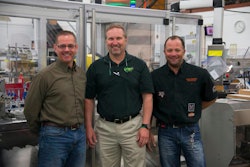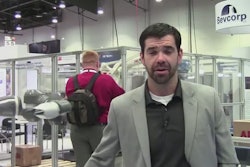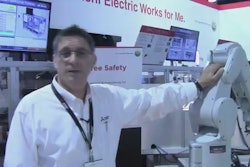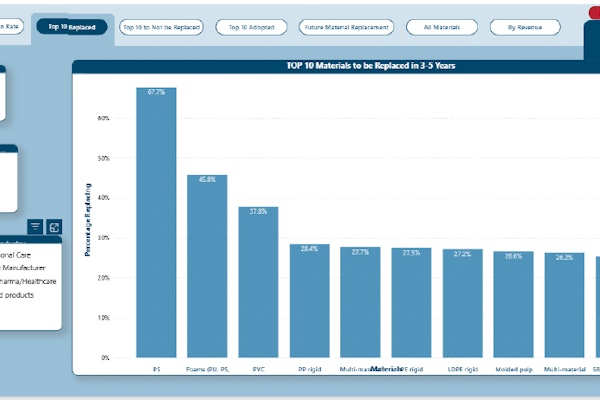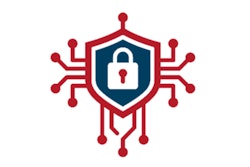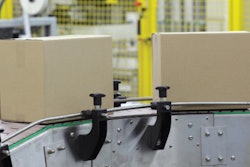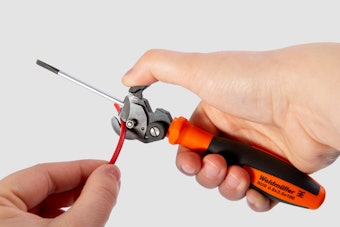
In 2016, industrial robots had a good year—the best ever, in fact. According to the Robotic Industries Association, robot orders in North America set new records, with a total of 34,606 robots valued at $1.9 billion ordered from North American companies—an increase of 10 percent in units over 2015. Shipments set new records as well, with 30,875 robots valued at $1.8 billion shipped to North American customers, growing 10 percent in units over the previous records set in 2015.
While these statistics include all industry sectors, packaging was certainly part of this trend. The food and consumer goods industry increased orders for robots by 32 percent in 2016, which could be specifically attributed to the need to improve food safety given the Food Safety Modernization Act (FSMA).
These OEMs teamed up with robotics suppliers to help end-user companies make the switch from a manual process on their packaging line to robotic automation.
BluePrint Automation creates built-in redundancy
Clif Bar & Company’s new Twin Falls, Idaho, bakery was engineered with speed, equipment redundancy, and system flexibility in mind. Key to attaining this speed is the use of a top-load robotic carton-loading system custom-designed by BluePrint Automation (BPA) that Senior Project Engineer Jeb Sloan explains provides the needed built-in redundancy to keep product in the system, even when there are equipment stoppages.
Sloan was looking for a system that could absorb minor stoppages over the course of a run. “If a piece of equipment were to go down, we wanted to have the ability to keep the line running, either by using a similar piece of equipment or by rerouting the product around the disruption and then reintroducing it back to the line,” he says. 
To address these requirements, BPA equipped each packaging line with a secondary packaging system comprising two Kliklok-Woodman Genesis top-load carton formers, ABB FlexPicker delta-style robots for carton loading, and two Kliklok Vari-Straight three-flap carton closers. The systems handle bars coming from Sigpack HCM horizontal flow wrappers supplied by Bosch Packaging Systems. After wrapping, the bars are carried by conveyor to the two packaging lines, consisting of carton forming and carton closing equipment on each side of the conveyor.
Jerry Buckley, Midwest regional sales manager for BPA, explains that cartons run on both sides of the product pick belt at 50 percent speed when both carton formers and carton closers are running, but if one jams and stops, then the cartons on the other side run at 100 percent speed, so that all bars can be placed into cartons on the side that is running. “Thus, all products go into cartons instead of into re-feed bins,” he says.
BPA also equipped each carton-loading system with two additional redundant robots, so that if one or two robots are being worked on, for example, having a suction cup changed, then the other robots will continue to load cartons.
“When you compare this technology to other systems that would solve the same problem, the only way to do that would be to buy more pieces of equipment to get the redundancy,” Sloan says. “With more pieces of equipment comes more square footage, more operators, more energy usage, and more complexity. We’re able to avoid having to do all that by using this robotic top-load system.”
Another advantage of the BPA solution is its vision-guided robotics system. Using a Cognex In-Sight bar-tracking vision system, the BPA carton loader’s vision system processor is fast enough to receive bars into the loader with no need for them to be rotated or have lanes balanced, which eliminates touches prior to picking. “This removes a known problem, as the bars can jam up at 90-degree turns, and there is no value in any additional touches,” Sloan says.
In similar applications, Buckley explains, SCARA robots do not have the reach to pick products from more than just the closest two lanes. “So if the cartons on that side of the product pick belt stop for some reason, then those bars just pass by the robots and go off the end of the pick belt for re-feeding,” he says.
With the Twin Falls system, the ABB FlexPicker robots can reach all lanes of incoming product, so there is never a time when the system can’t keep up with the product throughput, and all products are then put into cartons.
A feature on the BPA system is the touchscreen that allows for changes in the percentage of bars going into a certain-count carton. Therefore, if Clif Bar urgently needs to fill an order for 12-ct cartons, they can put 70 percent of the arriving product into the 12-ct carton side, with 30 percent going into the other carton being run—a 6-ct, for example—instead of always having 50 percent of product going into a carton on one side of the product conveyor and 50 percent on the other.
Following carton loading and sealing, the cartons are case-packed via four BPA model HPP robotic top-load case packers.
The secondary and tertiary packaging equipment is equipped with Allen-Bradley controls, integrated by BPA. BPA also programmed the systems to handle all of Clif Bar’s current packaging configurations as well as trained its operators to become self-sufficient on the machinery.
“BPA did the initial programming and setup, but we wanted to be sure the knowledge is transferred and our team members are well trained so that we’re able to do predictive and preventive maintenance on the systems ourselves,” Sloan says.
Looking at the system as a whole, Sloan says BPA delivered on all requirements—and more.
RocketFarm AS uses collaborative robot to fit meat processor’s floor-space
Oslo-based Nortura SA is a Norwegian agricultural cooperative that operates 33 slaughterhouses and other processing plants for the production of meat and eggs. At its Sogndal, Norway, plant, the company produces 2,200 tons of processed meat products annually, including cured ham, pepperoni, salami, and traditional Norwegian sausages. Until recently, palletizing of case-packed product at the facility was done manually. However, for employees, the work was repetitive and strenuous and provided few challenges.
While Nortura was eager to automate its palletizing operations, it had limited floor space in which to install a traditional palletizing robot, which requires a large, fixed cell with safety caging. The company wanted to be able to palletize continuously without stopping the production line, but needed the flexibility to use the space for other processes if there were no pallets in place.
With a limited budget, Nortura also had the added challenge of trying to find a cost-effective six-axis robot that had the required range and payload capacity to stack boxes of different sizes and weights at different heights on a pallet.
To meet Nortura’s challenges, robotics integrator Rocketfarm AS engineered a solution comprising a Universal Robots UR10 collaborative robot equipped with a UniGripper SMS 80-200 vacuum gripper, and a customized vision system for an innovative, small-footprint approach. Rocketfarm mounted the vision camera, an ifm O2D222 from ifm efector, Inc, in the ceiling 13 ft. above the robot, which is positioned below on a narrow stand.
“Basically, the robot is just mounted a couple of feet from the end of the conveyor. The robots are mounted ad hoc to the production lines, which means you don’t have to do any expensive construction work in order to further automate the palletizing, says Lars Bårdgard Åstveit, developer at Rocketfarm. “In general, production lines usually can’t be relocated, so our robots have to be very flexible in terms of where they can be placed.”
This was the case at Nortura. There were existing production lines, but the factory did not have any room for a big, centralized palletizing station. Thus, in order to automate the palletizing process, we had to be innovative and get rid of as many physical components as possible. Therefore, the only components of the entire palletizing solution are a camera, a robot, and a vacuum gripper.
“The floor is not leveled, but we are compensating for this in the software, hence the pallets are correctly stacked for transportation,” he says.
When the robot is in standby mode, its footprint is just 0.5 m2, or 1.6 sq. ft.; its working area is simply a painted space on the floor, which marks where operators place an empty pallet.
“We used maybe 10 percent to 20 percent of the space that a traditional robot would have used,” says Åstveit. “When there’s no pallet there, the space is free—it’s as if the palletizing system doesn’t exist.”
To begin the palletizing process, an operator places an empty pallet in the predefined area on the floor near the robot. The vision system then automatically detects the pallet and cases on the conveyor belt and begins palletizing.
Through intuitive, 3D visualization, the robot can be easily programmed to palletize cases in a specified pattern, such as turning them so that the labels are visible on all sides of the pallet. The robot can stack an average of 20 pallets/day, for a total of 1,700 cases/day.
“The UR10 is a robot that has all the right specifications,” Åstveit says. “It’s inexpensive, it has the range [1,300 mm.] that not many other cobots have, and it has the payload so it can lift the products we need it to lift. And it’s quite flexible in its programming.”
But one of its most important features for Nortura is its ability to work safely beside humans. The UR10 robot automatically stops if it runs into something that is not part of the planned path—even if that’s a human being standing on an empty pallet.
“If it didn’t have that capability, we wouldn’t have been able to use this robot,” Åstveit says. “It’s a critical feature—a deal breaker. Without the safety features of the UR10, we wouldn’t have been able to do this job.”
 JLS Automation increases throughput on new cheese-packaging line with robotic system
JLS Automation increases throughput on new cheese-packaging line with robotic system Barron County Cheese of Barron, Wisc., is a young and growing company that since 2010 has been converting and packaging dairy cheese for retail sale, offering services that include cutting, waxing, and smoking to cheese manufacturers and private-label companies. Over the last two years, the company has seen a major expansion of its business, prompting it to double its plant size from 6,000 to 12,000 sq. ft.
But as COO Gene Graf explains, despite its recent growth, Barron County is still a relatively small co-packer. As such, it is very cautious in its purchase of new equipment to ensure a successful return on investment.
Currently the company runs two packaging lines that produce shrink-wrapped product, with a third line for waxed product. In setting up the second line, Graf took a step-by-step approach, adding the packaging equipment first, with the end goal of automating with robotics the most manual process in the line: the loading of cheese into a horizontal form/fill/seal (hf/f/s) rollstock machine.
To convert and package product, Barron County first takes the raw material—bulk cheese in a variety of different sizes, widths, and heights—and cuts it with a three-way wire harp system to create an exact-weight piece, while minimizing the trim waste. From there, the cheese is cut into a specified weight and shape, such as round, square, wedge, or rectangular, using a custom-engineered, exact-weight titanium-blade ultrasonic cutter from Sodeva France.
The cheese is then carried by conveyor to a point where previously it was manually loaded into the pockets of the hf/f/s machine, the RapidPak RP-45. Once the cheese is loaded, the machine removes the air from the package by vacuum and seals it. From there, the package is carried through a Promax ST-700 automatic hot water shrink tunnel, followed by a Supervac air dryer from Supervac Maschinenbau GmbH.
According to Brian Friendshuh, Barron County Mechanical Engineer and a graduate from the Milwaukee School of Engineering, the drawback to manual loading was the inability of the line to maintain a consistent speed.
“The thermoformer [hf/f/s] was on its own, and we’d set it to run at a certain speed, no matter what speed product was being delivered to it,” he says. “So a lot of times product would come too fast, so we had to have a buffer there to collect overflow. At other times, product would come too slow, and the thermoformer would advance too fast, so we’d have to stop the machine so product could catch up. It was a very hectic job for the operators filling the machine.”
As Graf explains, for years he had envisioned adding robotics to Barron County’s operations, but was concerned about the cost and whether the machine could be integrated into an existing line.
In working with JLS Automation, Graf found a supplier that could provide a robotic loading system that not only could be integrated with Barron County’s existing machinery but could also handle a number of different cheese shapes and sizes.
The system specified by JLS is the Talon pick-and-place packaging system equipped with a Fanuc M-430iA five-axis, articulated, electric servo-driven robot that locates the cheese with its vision system, picks it up, and turns it vertically before loading it into the hf/f/s pocket. The robot uses two different suction-cup end-of-arm-tools: a flat grabbing surface for round, square, and rectangular products, and an angled grabbing surface for wedge-shaped cheese.
The EOAT is ideal for sanitary requirements, incorporating JLS’s Vacuum On Board 2.0 single-stage vacuum pump technology, which eliminates vacuum hosing and tubing.
“The suction cup is the only place where debris can get sucked in,” Graf explains. “So when you’re done running the product, you can just take the suction cup off, and that’s all you have to clean, rather than having to clean out a vacuum line.”
He adds that JLS worked with the USDA and the Department of Agriculture in Wisconsin to ensure that the equipment complied with food-grade requirements for handling cheese products. This included the use of stainless steel and a complete washdown system.
JLS integrated the Talon with the RapidPak’s Allen-Bradley operating system, which Graf says is one of the huge benefits of the system for Barron County.
“Depending on what the upstream cutter is doing, the system can communicate with the RapidPak to speed it up or slow it down without anyone touching anything,” he says.
Before the system was delivered to Barron County, JLS programmed the robot with six different recipes, to accommodate the different sizes and shapes being run on the line. JLS also trained Friendshuh at its facility in York, Pa., to program the machine for future products and to make adjustments to the system.
With the addition of the Talon system, Graf says the line now runs consistently at 60 pieces/min, which has increased efficiency and throughput, has resulted in less fatigued employees, and has freed up operators to perform more food safety inspection—“and honestly,” he says, “that has an impact on cost.”

